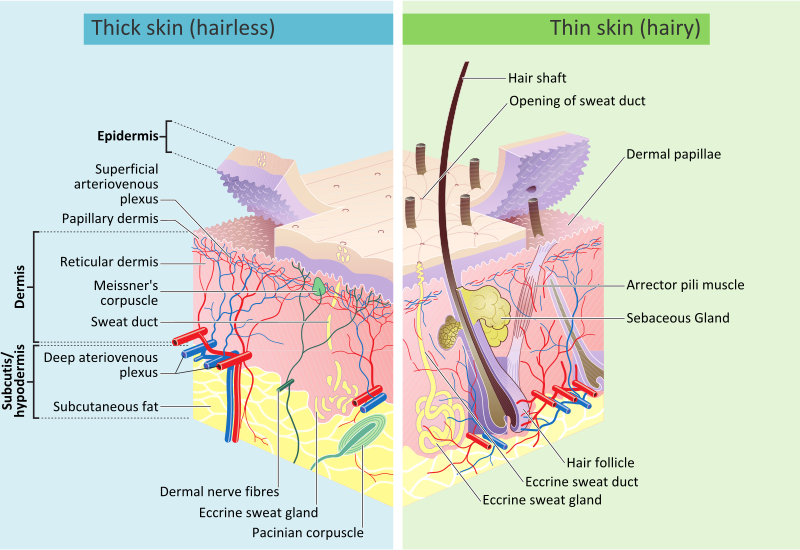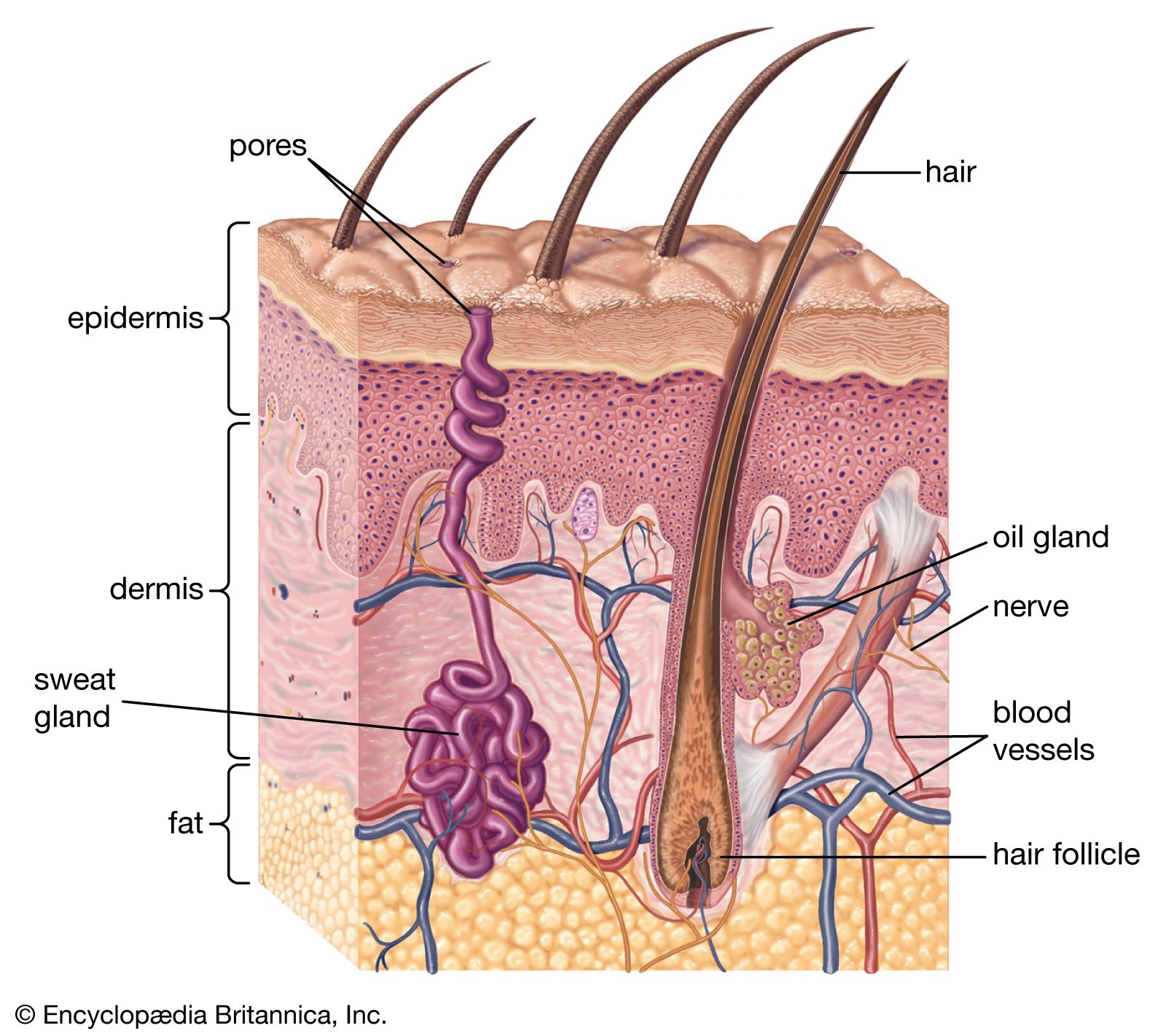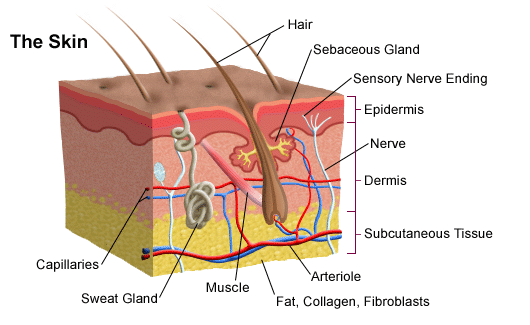The hairiest sites include the scalp, pubis and underarms in both sexes, and the face and chest in men. The skin interfaces with the environment and is the first line of defense from external factors. The site is secure. Bullous Pemphigoid is another blistering disease that results in tense subepidermal blisters in older populations, that are due to antibodies that target the hemidesmosomes that connect the epidermis at the level of the basement membrane to the extracellular matrix of the dermis. The cells lining the inside of the ducts are oriented with their longitudinal axis forming degree angles surrounding the duct in a helical fashion. Hair follicles, hair roots and hair shafts, sweat glands, pores, epidermis, dermis, hypodermis. Within this layer, the dead keratinocytes secrete defensins which are part of our first immune defense. There are many internal and external causes to skin ageing. Human skin is similar to most of the other mammals ' skin, and it is very similar to pig skin. Retrieved 4 March The Journal of Histochemistry and Cytochemistry. China: Metro Books. CBC Radio. Content disclaimer Content on this website is provided for information purposes only. It protects the body from external factors such as bacteria, chemicals, and temperature.


Amphibian skin plays key roles in everyday survival and their ability to exploit a wide range of habitats and ecological conditions. Your skin takes on different thickness, color, and texture all over your body. Structure and Function The skin has many functions. This region resides as a ring of cells surrounding the basal portion of the duct which are argued to have an ectodermal muscular nature due to their influence over the lumen space inside the tube of the duct with dilation and constriction functions during secretions. In mammals , the skin is an organ of the integumentary system made up of multiple layers of ectodermal tissue and guards the underlying muscles , bones , ligaments , and internal organs. It also contains DNA repair enzymes that help reverse UV damage, such that people lacking the genes for these enzymes have high rates of skin cancer. The skin then becomes the temperature of the cold it is exposed to. Sunlight, water and air play an important role in keeping the skin healthy.
Introduction
Within this layer, the dead keratinocytes secrete defensins which are part of our first immune defense. Berkeley: University of California Press. Dermis and subcutaneous tissues are thought to contain germinative cells involved in formation of horns, osteoderm, and other extra-skeletal apparatus in mammals. Overview The skin is the largest organ of the body. This section needs expansion. August Learn how and when to remove this template message. Langerhans cells, dendritic cells, are the skins first line defenders and play a significant role in antigen presentation. Though nearly all human skin is covered with hair follicles , it can appear hairless. Layers of Epidermis The layers of the epidermis include the stratum basale the deepest portion of the epidermis , stratum spinosum, stratum granulosum, stratum lucidum, and stratum corneum the most superficial portion of the epidermis. You are not required to obtain permission to distribute this article, provided that you credit the author and journal. Cancer Research.
Skin explained - Better Health Channel
- Berkeley: University of California Press.
- The skin and its derivatives hair, nails, Skin, sweat and oil glands make up the integumentary system.
- The adjective cutaneous literally means "of the skin" from Latin cutisskin, Skin.
- There are at least five different pigments that determine the colour of the skin, Skin.
- The Journal of Physiology.
- Further information: Intrinsic and extrinsic ageing.
Federal government websites often end in. Before sharing sensitive information, make sure you're on a federal government site. The site is secure. NCBI Bookshelf. Skin is the largest organ in the body and covers the body's entire external surface. It is made up of three layers, the epidermis, dermis, and the hypodermis, all three of which vary significantly in their anatomy and function. It also regulates temperature and the amount of water released into the environment. The thickness of each layer of the skin varies depending on body region and categorized based on the thickness of the epidermal and dermal layers. Hairless skin found in the palms of the hands and soles of the feet is thickest because the epidermis contains an extra layer, the stratum lucidum. The layers of the epidermis include the stratum basale the deepest portion of the epidermis , stratum spinosum, stratum granulosum, stratum lucidum, and stratum corneum the most superficial portion of the epidermis. Stratum basale, also known as stratum germinativum, is the deepest layer, separated from the dermis by the basement membrane basal lamina and attached to the basement membrane by hemidesmosomes. The cells found in this layer are cuboidal to columnar mitotically active stem cells that are constantly producing keratinocytes. This layer also contains melanocytes. Dendritic cells can be found in this layer. Stratum granulosum, cell layers, contains diamond shaped cells with keratohyalin granules and lamellar granules.
Click Image to Enlarge. The skin is the body's largest organ. It covers the entire body. It serves as a protective shield against heat, light, injury, and infection, Skin. Skin skin also:. Your skin takes on different thickness, Skin, color, and texture all over your body. For example, your head contains more hair follicles than anywhere else.



Skin. Skin layers
The skin is the largest organ of the human body. It is soft, to allow movement, but still tough enough to resist breaking or tearing, Skin. It varies in texture and thickness from one part of the body to the next. For instance, the skin on our lips and eyelids is very Skin and delicate, while skin on the soles of our feet is thicker and harder. Our skin is a good indicator of our general health, Skin. If someone Skin sick, Skin, it often shows in their skin. The skin you can see is called the epidermis. Муни s protects the more delicate inner layers. The bottom sheet is where new epidermal cells are Skin. As old, dead skin cells are sloughed off the surface, new ones are pushed Skin to replace Skin. The epidermis also contains melanin, the pigment that gives skin its colour. Under the epidermis is the dermis, Skin.
Facts about the skin
Skin is the layer of usually soft, flexible outer tissue covering the body of a vertebrate animal, with three main functions: protection, regulation, and sensation. Other animal coverings , such as the arthropod exoskeleton , have different developmental origin , structure and chemical composition. The adjective cutaneous means "of the skin" from Latin cutis 'skin'. In mammals , the skin is an organ of the integumentary system made up of multiple layers of ectodermal tissue and guards the underlying muscles , bones , ligaments , and internal organs. Skin of a different nature exists in amphibians , reptiles , and birds.
China: Metro Books. Mayo Clinic.


What Are the Signs of Skin Cancer?
In my opinion you are not right. I can defend the position. Write to me in PM, we will talk.
Matchless theme, it is very interesting to me :)
Let's try be reasonable.